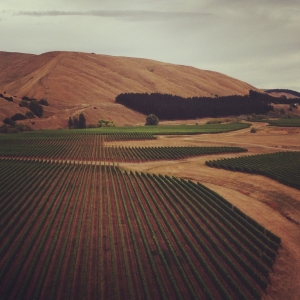The Wine, in Brief
Bunch architecture, the Abel clone, and in some cases vine age, define Martinborough Pinot Noir, producing wines with unmistakable plum flavors and a full, dense tannic structure with a silken texture. The weather during flowering is typically very windy, which inhibits fruit set and tends to produce small, open clusters, giving a consistently poor yield of thick-skinned, high quality grapes. The Abel clone, a smuggled gumboot cutting allegedly from Domaine de la Romanée-Conti that was confiscated by customs officer Malcolm Abel, was adopted by Clive Paton at Ata Rangi and is now a trademark of the region.
Location
The region of Martinborough surrounds the town of the same name, at the southern tip of New Zealand’s North Island. The region lies within the Wairarapa Plains, in the lee of the Rimutaka and Tararua Ranges to the west, and north of Palliser Bay (which faces Marlborough’s Cloudy Bay across the Cook Strait).
Historical Background
William Beetham introduced Vitis vinifera to the Wairarapa region in 1883 when he planted a three-acre vineyard, named Landsowne, near Masterton. In 1897 he produced the first wine from the area, a Pinot Noir, which was shown in Paris. The temperance movement halted the development of the fledgling wine region when Wairarapa became one of the first districts in New Zealand to vote against the sale of alcohol in 1908; many of the vines were pulled out.
In 1979, a government soil science report identified Martinborough as having climate and soils remarkably similar to Burgundy. Two of the scientists involved were so convinced of Martinborough’s potential that they planted vines and became two of the four founding Martinborough wine pioneers. Dr. Neil McCallum of Dry River planted his first vines in 1979, and was followed the next winter by Clive Paton of Ata Rangi, Derek Milne of Martinborough Vineyards, and Stan Chifney of Chifney Wines. In the beginning it was Stan Chifney who had the only winery in town, and the other three producers shared his facility for the first couple of years.
In 1986, a group of the region’s then fledgling wine producers banded together to introduce the Martinborough Terrace Appellation of Origin System. Wines grown and produced in the designated area were entitled to wear the appellation seal on their bottles as a stamp of authenticity. The use of the seal has been largely abandoned, however, in part because the appellation’s boundaries were arbitrary, excluding very similar soils and climates.
Climate and Weather
Martinborough has a cool, semi-maritime climate, influenced to a small degree by the coastlines to the south and west; the region experiences 1080 growing degree-days. Martinborough is the driest region in the North Island, with only 780 mm of rain per year, falling mostly in winter and spring. Any rain that does reach Martinborough, particularly during harvest, comes from the unprotected south; consequently, the rains are cold and botrytis infection doesn’t follow. Spring frosts are a major risk, and the cold, dry westerlies that prevail during spring and summer can upset flowering. Both frost and wind tend to keep yields low, and disease pressure is very low throughout the year.
Soils and Topography
The vineyards of Martinborough are planted in and around foothills on the eastern edge of the Wairarapa Plains, principally on terraces formed by two rivers – the Ruamahanga (the larger, which drains all of the Wairarapa Plains as it flows south to Palliser Bay) and the Huangarua (which meets the Ruamahanga just north of Martinborough). These rivers have carved out dramatic cliffs and escarpments, exposing stony sub-soils, and have built up deep alluvial terraces. The Martinborough Terrace, which is only one kilometer wide and five kilometers long, has silt loam topsoil, with loess in some places, over very deep gravel deposits (up to 15 meters deep).
Grape Varieties
Wairarapa is New Zealand’s seventh-largest growing region, with a producing area of 942 hectares (3% of the national producing area) across 98 vineyards, giving an average vineyard size of 9.2 hectares. Wairarapa is planted primarily to Pinot Noir (51%) and Sauvignon Blanc (33%), with significant plantings of Pinot Gris (6%), Chardonnay (4%), and Riesling (3%).
Sources
Michael Cooper, Wine Atlas of New Zealand (Auckland, NZ: Hodder Moa, 2008).
Caroline Courtney, Wine in New Zealand (Auckland: Godwit, 2003).
Hugh Johnson and Jancis Robinson, The World Atlas of Wine Sixth Edition (London: Octopus Publishing Group, 2007).
Kevin Judd and Bob Campbell, The Landscape of New Zealand Wine (Nelson, NZ: Craig Potton Publishing, 2009).
New Zealand Winegrowers, “Vineyard Register Report 2012,” http://www.wineinf.nzwine.com.
Wines from Martinborough, http://www.winesfrommartinborough.com

